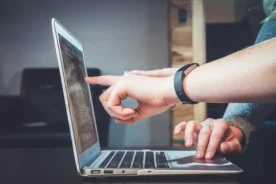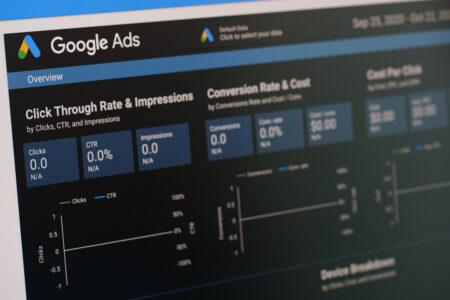What exactly is eye-tracking? How can it improve UX design? And should you be using it? Read on to find out!
What is eye tracking?
As the name suggests, eye-tracking records the eye’s movements and allows you to see where users are looking on screen and what catches (or escapes) their attention. It can be used to track eye movements on videos, static adverts, and websites. Knowing this information lets you know if your users are noticing your key messaging and your call-to-action buttons, along with other key UI elements. What’s more, the technology doesn’t just tell you where users are looking, but also how long they’re looking for. This gives you a great understanding of what is really grabbing their attention and what is being overlooked.
The areas where users’ eyes are focused are known as ‘fixations’. Eye-tracking also shows us when users’ eyes are in motion and missing elements, these are called ‘saccades’. If a key element you want users to look at is in a saccade, then a UX consultant can make suggestions for improvements based on the eye-tracking data.
Heatmaps
We carry out qualitative eye-tracking tests where the recordings are manually reviewed by our UX consultants, we also produce heatmaps (see below) which are a visual way to present the findings. We like to carry out the testing with at least 20 participants, this allows us to get enough valuable data and discard any outliers from the findings. The heatmap is a really useful way to visualise the data, areas in green are where some users looked, whereas red areas are where most fixations happened. This clearly shows what is grabbing the most attention and which areas are being missed.

Heatmaps can be presented for one participant or as an amalgamation of all the participants. Along with heatmaps, there are also gaze maps, these show the order that users look at different elements and identify whether elements were looked at multiple times.
UX problem solving
Eye-tracking results show how users are using the product but not why. Based on the data produced, a UX consultant will be able to see why an area had a lot or very few fixations. An area that got a lot of fixations could be for positive or negative reasons. For example, is it because it had a catchy heading? Or is it because it didn’t work as expected and is acting as a pain point for the user? A UX consultant will be able to analyse the data and recordings from the usability tests to identify any issues for the user in the process.
It can be a very powerful tool for finding why you are missing key conversions and help inform CRO opportunities. You may have a button on your website that no one is clicking. Is this because they aren’t engaged with the text above? Or because it was not in their gaze path? Eye-tracking pinpoints exactly where the user is looking. It can also be combined with the movements of the cursor so you can see where they looked and if they then clicked to go further in the journey.
A/B testing
Eye-tracking can be a great tool if you want to test out different ideas. You could have two different versions of a landing page or static graphic for example, and test out different font sizes, terminology, colours, etc. to see what grabbed the most user attention. If you pair eye-tracking with facial expression software, you can see not only what they looked at but also the feelings that the visuals evoked. These scientific methods take the guesswork out of what is the best method for your next website, advert etc. and give you a much greater chance at success.
Areas of interest (AOI)
Along with the heatmaps you can also be presented with AOI’s. These are handy blocks of information that tell you what percentage of users looked at a specific element (for example a button), on average how long for, how many fixations they had in that region, on average how long it took them to see that element, and so much more! It provides a lot of data and can be applied to different elements of your website, video etc.
Thing to consider
Eye-tracking is the closest you will come to viewing your product through the eyes of your users. Though, like all great things in life, it takes time, and with that you need a budget for the project. The first part of the project is knowing what you actually want to test. Is it a landing page that isn’t converting well? Or are you launching a new product and want to see how engaging your colour choices are? Eye-tracking tests need clear objectives to get the most out of them.
Once the testing environment has been set up you also need to factor in how much it costs to source and pay for participants. Lastly, analysing the data takes a skilled professional to go through the data and footage to work out why people have fixations in certain areas and not others, then come up with suggestions for improvements. So, while eye tracking is a great testing method, you need to make sure you have the necessary budget for it. There are also other more cost-effective paths you could go down, such as A/B testing or standard usability tests.
Key takeaways
Eye-tracking is a great way of testing your product, through it you can:
- See if participants are missing key UI components
- Find out if there are elements on your website that are distracting users from the call-to-action buttons.
- Identify whether there are pain points in the journey causing a lot of fixations.
- Discover which content users are and aren’t reading.
- Find out how long it takes for users to see different elements.
- See how long users look at different elements for.
- Identify whether there are elements users look at but don’t click.
Overall, eye-tracking gives you invaluable data that other traditional UX methods can’t provide. If you are already carrying out observation, user interviews, surveys and A/B testing then eye-tracking can be a great leap forward.
If you would like to better understand how biometrics & UX can be used to improve your digital strategy, please get in touch. Alternatively, you can check out our free Biometric Testing for Digital Marketing guide.
Let's collaborate
Partner with us
Let’s work together to create smarter, more effective solutions for your business.
Related blogs
Who we are
Explore how our culture and expertise fuel digital innovation
Join us







